Razer Blade 14 Review: Zen 4 Ryzen-Powered Mobile Powerhouse
Razer Blade 14 (2023) Review: System Benchmarks, Game Performance And Battery Life
Prior to running any benchmarks on a system, we apply all of the latest Windows and driver updates available for it. Our particular Razer Blade 14 sample shipped with Windows 11 Home 22H2 and needed minimal updating, save for the latest Game Ready GeForce drivers, Windows Store updates, and some Razer Synapse related updates. Other than applying those updates (like most consumers would), we run all of our tests with out-of-the-box settings. Our goal is to test the system as it ships, but after auto-updating, to accurately reflect what buyers can expect from a retail experience.
The Razer Blade 14, however, adds an additional wrinkle. This machine gives users the option to run the CPU and GPU in higher performance boost modes when on AC Power, so we tested the system both in its default Balanced mode and with the CPU and GPU unconstrained, except for our battery life tests where where only the "Balanced" hybrid mode was available.
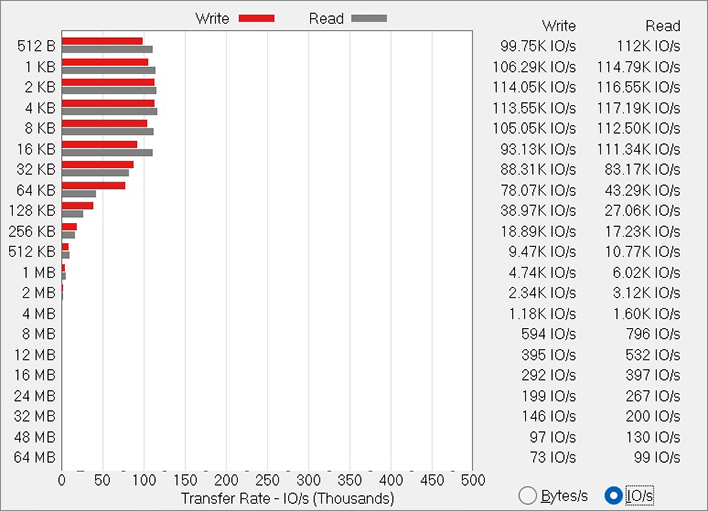

Our Razer Blade 14 sample features a single 1TB Samsung PCI Gen 4 NVMe SSD, which performed well. We saw peak reads of over 6.2GB/s, with writes of over 4.6GB/s. While this drive may not be the fastest SSD we've seen in a notebook, it is still plenty fast for gaming and for everyday computing tasks.

In all fairness, browser updates can, and often do, result in increased performance in this benchmark. Unfortunately, we don't have all of these notebooks on hand perpetually to re-run these tests when necessary. That said, we don't expect the overall standings to be all that different. The Razer Blade 14 with its Ryzen 9 7940HS jumped out in front of all of the other more mainstream laptops and trails only the top-end models based on higher-power HX series processors.

The higher-power mode on the Razer Blade 14 had a significant impact on the multi-threaded score in Cinebench. With it enabled, the Ryzen 9 7940HS hangs with the 12900HH here. In Balanced mode, however, the Ryzen 9 7940HS is about 10% faster than the 6900HS, when it too is running in Balanced mode. When the 6900HS is operating in its equivalent Turbo mode, the chips' multi-threaded scores are about on par with each other.

The Ryzen 9 7940HS-powered Razer Blade 14 outguns the previous-gen 6900HS in Geekbench's multi-threaded test, but it can't quite catch the higher core count processors. In the single-threaded test, however, the Razer Blade 14 performs among the best overall.

The Razer Blade 14 performed exceptionally well in PCMark 10. Here, the Razer Blade 14 was able to outrun all of the other mainstream laptops and trails only the much bigger, higher-power, higher-core count notebooks.

The GeForce RTX 4070 in the Razer Blade 14 performs about on par with the previous-gen GeForce RTX 3080 and 3080 Ti mobile GPUs, according to 3DMark Timespy. The different power modes had minimal impact on performance, but the 140w available to the GPU paid huge dividends. Compare the XPS 15's performance with the Blade 14 and the advantages of the additional power headroom become obvious.
Next up, let's take a look at the Extreme preset for the punishing 3DMark Fire Strike test. This DirectX 11 test has been around for a while, but it's still pretty challenging for mobile GPUs.

We saw a similar performance trend in Fire Strike. The Razer Blade 14's GeForce RTX 4070 outguns the RTX 3070 Ti and hangs with the RTX 3080 and 3080 Ti.
Lastly, the Port Royal test uses DirectX Ray Tracing (DXR) along with traditional rasterization techniques to illuminate a scene...

DXR hardware is a requirement for this test, so we don't have quite as many machines represented. Still, the Blade 14 lands in a similar position, outperforming the other more mainstream laptops and trailing only the much larger, higher-power devices.

For a quick sanity check, we also tested the performance on the Ryzen 9 7940HS' integrated Radeon 780M GPU. Though it trailed the performance on the 680M (as configured in the ROG Zephyrus G14), the Radaeon 780M's performance is head and shoulders above any Intel IGP, and about 2x as fast as the pared down Radeon in the Ryzen 7045HX series processors.



The Tomb Raider benchmark has the Blade 14 performing about on par with previous-gen GeForce RTX 3080 Ti-powered laptops, which is to say the Blade 14 is performing exceptionally well considering its much more compact and portable form factor.

We saw more of the same in F1 2021. The GeForce RTX 4070 in the Blade 14 has plenty of breathing room and is able to compete favorably with higher-powered gaming laptops built around the GeForce RTX 3080 Ti.

Note there are two scores for the Razer Blade 14 in this game -- one at native resolution and another with DLSS (Balanced Mode) enabled. Once again, we see the GeForce RTX 4070 in the Balde 14 landing somewhere in between the GeForce RTX 3080 and RTX 3080 Ti. With DLSS enabled, performance jump about 35% and frame rates land in triple-digit territory.

Razer claims 10 hours of up-time on battery power with the Blade 14. We didn't quite hit that mark in our tests, but the Blade 14 still performed relatively well. In PCMark Video battery life test, the machine lasted more than 7.5 hours, which is great considering how much performance is available in this relatively svelte machine.

When running a simulated gaming workload where the Razer Blade 14's CPU, GPU, memory and storage are getting taxed simultaneously, battery life is obviously lower, but it still relatively strong. The Blade 14 ran for nearly 2 hours on battery which isn't bad at all, relative to other high-performance gaming laptops.
The Razer Blade 14, however, adds an additional wrinkle. This machine gives users the option to run the CPU and GPU in higher performance boost modes when on AC Power, so we tested the system both in its default Balanced mode and with the CPU and GPU unconstrained, except for our battery life tests where where only the "Balanced" hybrid mode was available.
ATTO Disk Benchmark
The ATTO disk benchmark is a fairly quick and simple test which measures read/write bandwidth and IOPS across a range of different data sizes. While we don't typically compare these results across multiple machines, it's useful to gauge whether a particular notebook's storage subsystem is up to snuff.
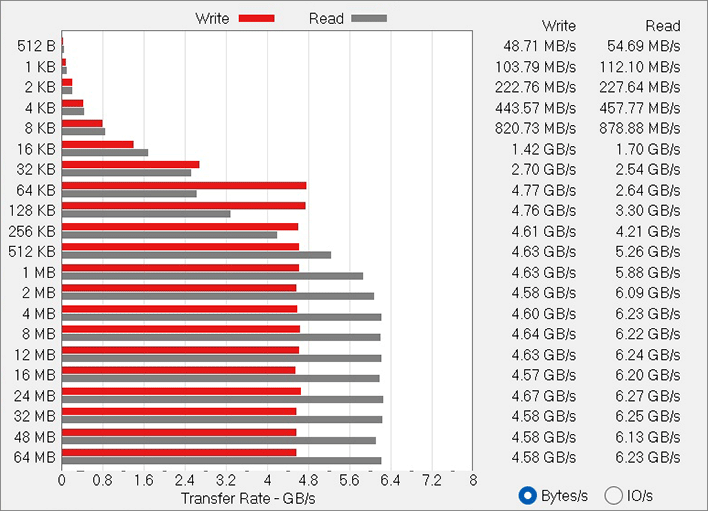
Our Razer Blade 14 sample features a single 1TB Samsung PCI Gen 4 NVMe SSD, which performed well. We saw peak reads of over 6.2GB/s, with writes of over 4.6GB/s. While this drive may not be the fastest SSD we've seen in a notebook, it is still plenty fast for gaming and for everyday computing tasks.
Speedometer 2.0 Browser Benchmark
We use BrowserBench.org's Speedometer test to gauge our web experiences, which takes a holistic look at web application performance. This test automatically loads and runs several sample web apps from ToDoMVC.com using the most popular web development frameworks around, including React, Angular, Ember.js, and even vanilla JavaScript. This test is a better example of how systems cope with real web applications, as opposed to a pure JavaScript compute test like JetStream. All tests were performed using the latest version of Chrome.
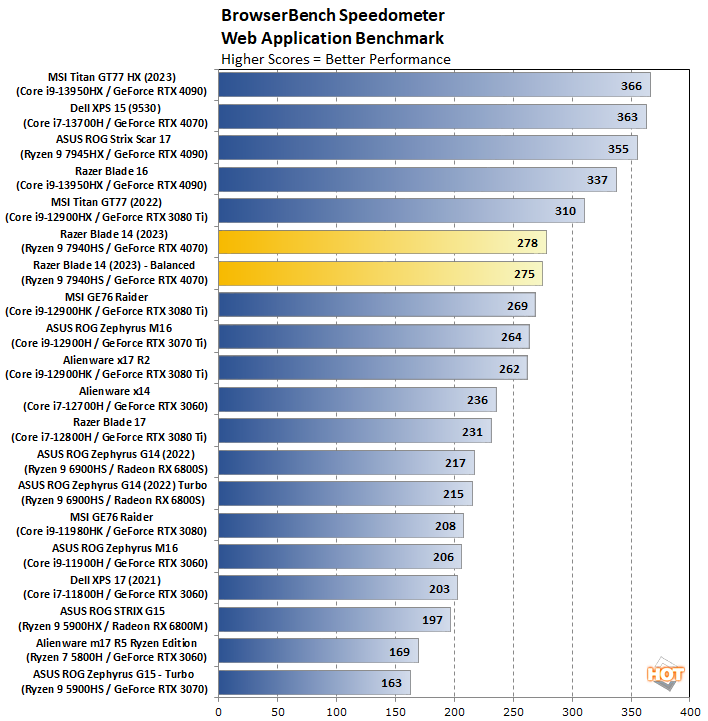
In all fairness, browser updates can, and often do, result in increased performance in this benchmark. Unfortunately, we don't have all of these notebooks on hand perpetually to re-run these tests when necessary. That said, we don't expect the overall standings to be all that different. The Razer Blade 14 with its Ryzen 9 7940HS jumped out in front of all of the other more mainstream laptops and trails only the top-end models based on higher-power HX series processors.
Cinebench R23 Rendering Benchmark
This is the latest 3D rendering benchmark from Maxon, based on the Cinema 4D R23 rendering engine. We tested both single-threaded and multi-threaded tests on all of the notebooks represented here...
The higher-power mode on the Razer Blade 14 had a significant impact on the multi-threaded score in Cinebench. With it enabled, the Ryzen 9 7940HS hangs with the 12900HH here. In Balanced mode, however, the Ryzen 9 7940HS is about 10% faster than the 6900HS, when it too is running in Balanced mode. When the 6900HS is operating in its equivalent Turbo mode, the chips' multi-threaded scores are about on par with each other.
Geekbench 5 Benchmarks
Geekbench is a cross-platform benchmark that simulates real world processing workloads in image processing and particle physics scenarios. We tested the notebooks featured here in Geekbench's single and multi-core workloads. It measures single-threaded performance allowing a single core to stretch its legs, and multi-threaded throughput to put all cores under a heavy load.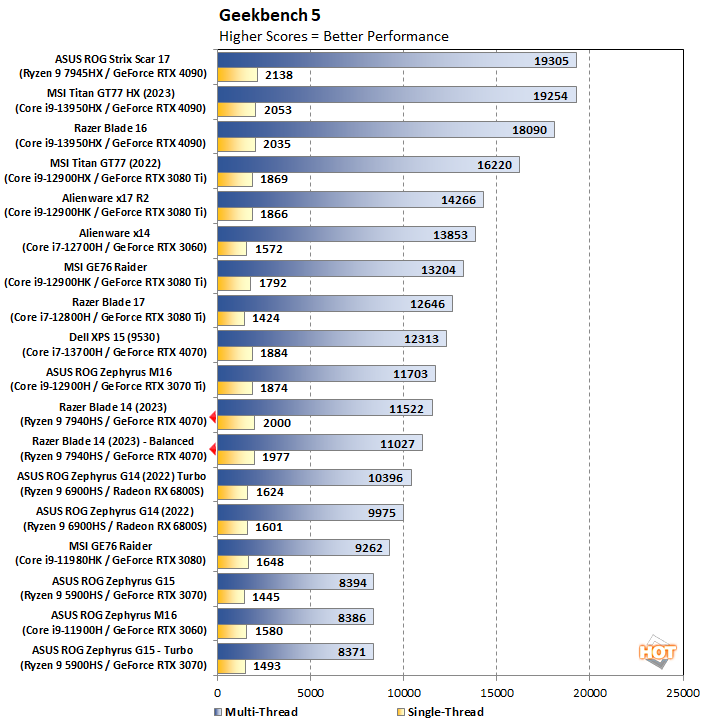
The Ryzen 9 7940HS-powered Razer Blade 14 outguns the previous-gen 6900HS in Geekbench's multi-threaded test, but it can't quite catch the higher core count processors. In the single-threaded test, however, the Razer Blade 14 performs among the best overall.
PCMark 10 Whole System Benchmarks
PCMark 10 uses a mix of real-world applications and simulated workloads to establish how well a given system performs productivity tasks, including image and video editing, web browsing, and OpenOffice document editing. While these scores appear to be all over the place, the systems are sorted by their overall PCMark score, which is the third (gray) bar in each cluster.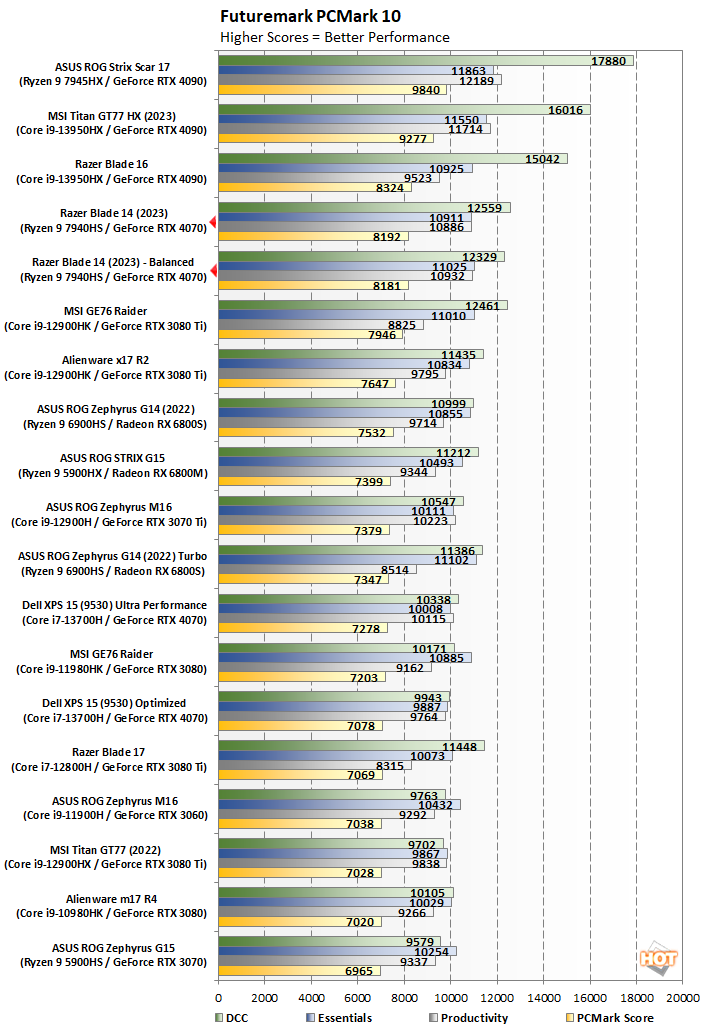
3DMark Graphics And GPU Tests
3DMark has several different graphics tests which focus on different types of systems. We start with Time Spy, which was 3DMark's headline benchmark until just recently. This test presents a pretty significant challenge for the system's CPU and GPU using DirectX 12's API...
The GeForce RTX 4070 in the Razer Blade 14 performs about on par with the previous-gen GeForce RTX 3080 and 3080 Ti mobile GPUs, according to 3DMark Timespy. The different power modes had minimal impact on performance, but the 140w available to the GPU paid huge dividends. Compare the XPS 15's performance with the Blade 14 and the advantages of the additional power headroom become obvious.
Next up, let's take a look at the Extreme preset for the punishing 3DMark Fire Strike test. This DirectX 11 test has been around for a while, but it's still pretty challenging for mobile GPUs.

We saw a similar performance trend in Fire Strike. The Razer Blade 14's GeForce RTX 4070 outguns the RTX 3070 Ti and hangs with the RTX 3080 and 3080 Ti.
Lastly, the Port Royal test uses DirectX Ray Tracing (DXR) along with traditional rasterization techniques to illuminate a scene...
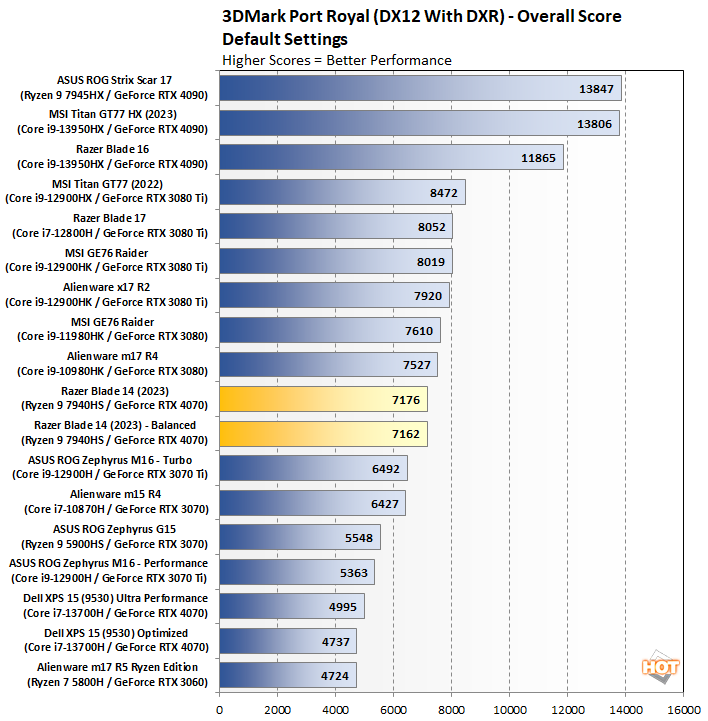
DXR hardware is a requirement for this test, so we don't have quite as many machines represented. Still, the Blade 14 lands in a similar position, outperforming the other more mainstream laptops and trailing only the much larger, higher-power devices.
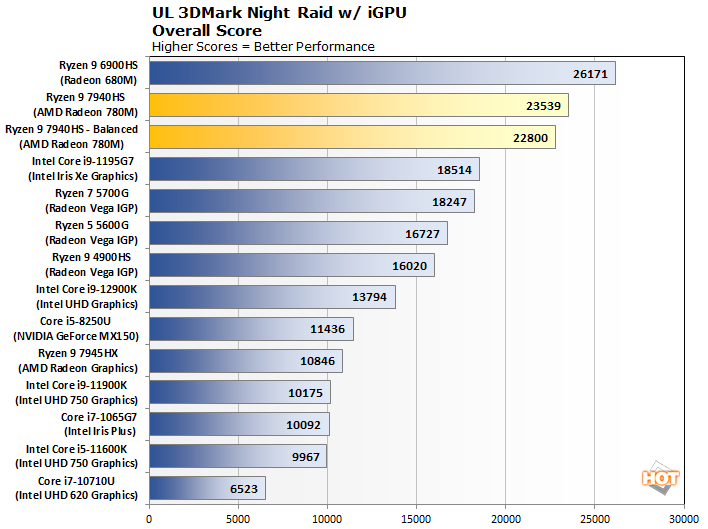
Middle Earth: Shadow Of War Tests
Middle Earth: Shadow of War is a fun and and beautiful title set in Tolkien's Lord of the Rings universe. To test the game's performance relative to other systems, we set the resolution to 1920x1080 and 2560x1440 and turned the visuals up to the High preset. The frame rates here are the average reported by the built-in benchmark.
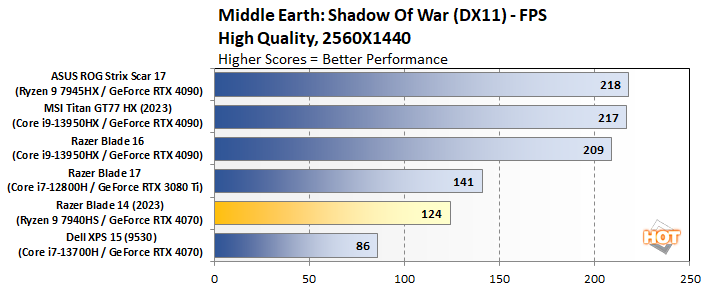
In the first of our actual game tests, we're going to show results at two resolutions, 1080p because that's where we've got the most reference data, and 1440p. In the 1440p tests, we only have results from a handful of notebooks, but we nonetheless wanted to show how the RTX 4070 performed relative to some other machines. At 1080p, where the GPU is less of a bottleneck, the Ryzen 9 7940HS in the Blade 14 helps push it up the stack where it competes well with larger laptops featuring the RTX 3080. At 1440p, the Blade 14 is still able to achieve triple-digit framerates and lands just behind the RYX 3080 Ti. Note how much better the Blade 14 performs than the Dell XPS 15, even though they technically features the "same" GPU.
Note as you peruse the other game tests that 1440p (2560x1440) was not available to test, without manually altering game files. It simply wasn't an option in the game menus.
Note as you peruse the other game tests that 1440p (2560x1440) was not available to test, without manually altering game files. It simply wasn't an option in the game menus.
Shadow Of The Tomb Raider Benchmarks
The finale in the rebooted Tomb Raider trilogy, Shadow of the Tomb Raider is easily the best-looking of the bunch. It's also brimming with Tobii eye-tracking hardware support, and leading edge graphics technologies. To test this game out, we again turned the visuals up to their highest preset and tested at the FullHD resolution of 1920x1080.
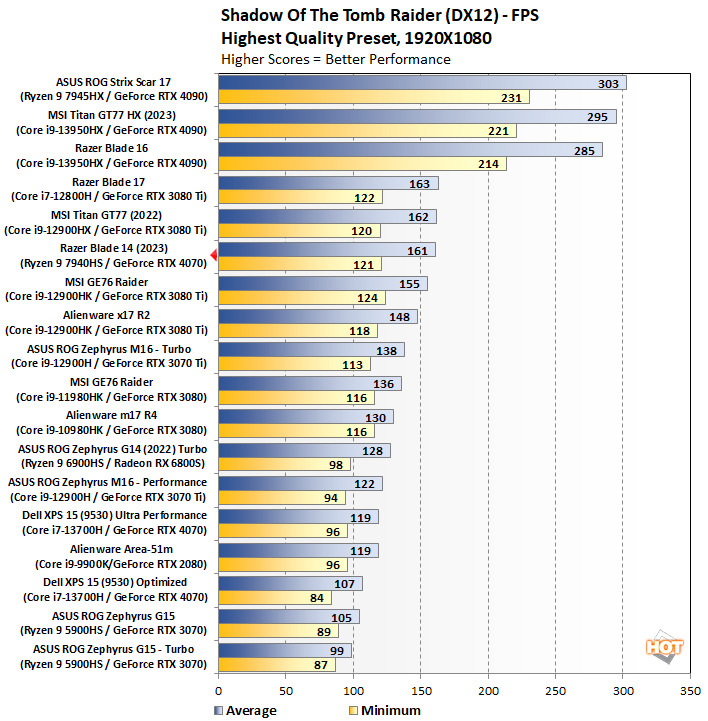
The Tomb Raider benchmark has the Blade 14 performing about on par with previous-gen GeForce RTX 3080 Ti-powered laptops, which is to say the Blade 14 is performing exceptionally well considering its much more compact and portable form factor.
F1 2021 Benchmarks
F1 2021 supports DirectX 12 with ray tracing, and it incorporates support for a number of AMD's FidelityFX Super Resolution (FSR) and NVIDIA technologies (like DLSS). We tested the games with its Ultra High graphics preset, with ray-tracing and TAA enabled at a couple of resolutions to see what the Razer Blade 16 could do...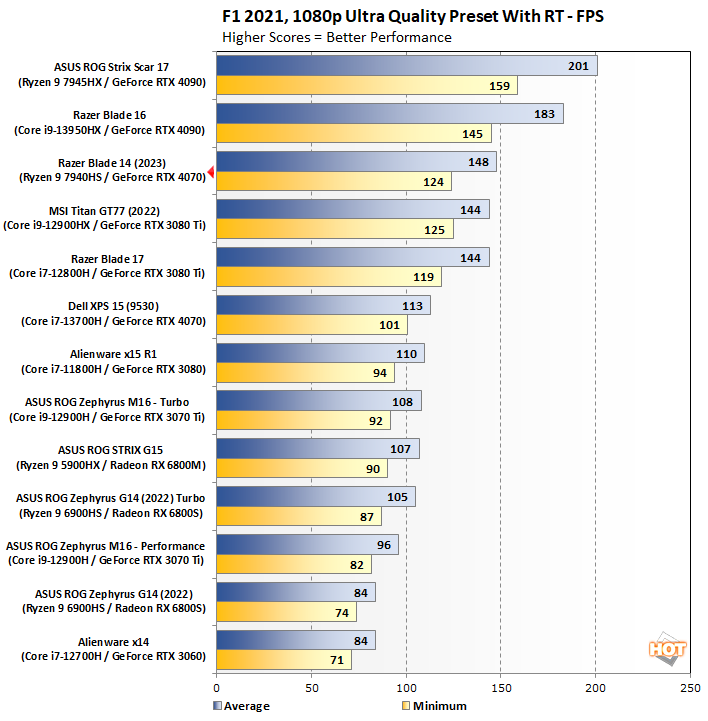
Marvel's Guardians Of The Galaxy
Marvel’s Guardians of the Galaxy is an action-adventure game where you play as Star-Lord and lead the rest of the Guardians from mission to mission. The game’s minimum requirements call for a Radeon RX 570 or GeForce GTX 1060-class GPU, but it also supports some of the latest graphics technologies, including DXR and DLSS.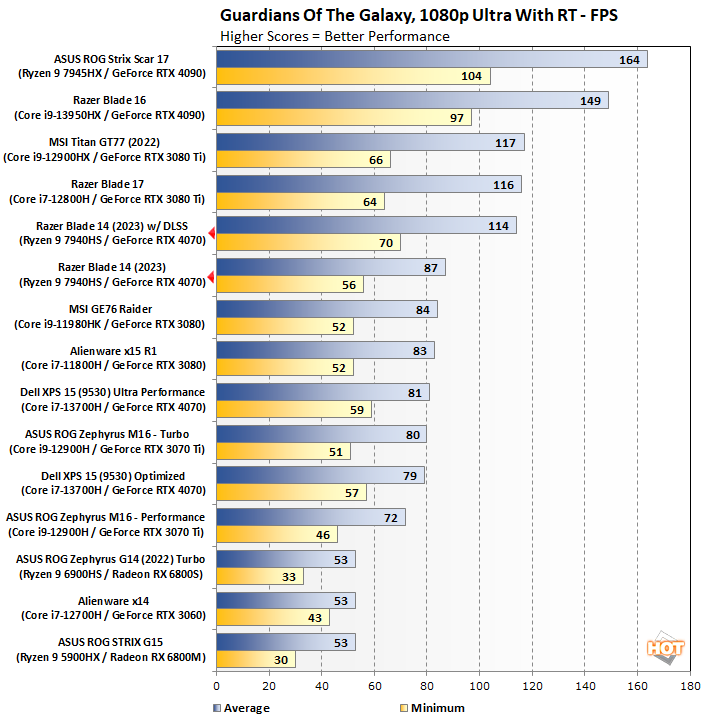
Battery Life And Power Tests
We run a 1080p HD video loop that's part of the PCMark 10 suite, to prove out battery life with our test group of machines. In all tests, Windows Quiet Hours / Focus Assist has been enabled and the displays are calibrated with lux meters on pure white screens to as close to 115 lux as possible. For the average laptop this is somewhere between a 40-60 percent brightness setting.
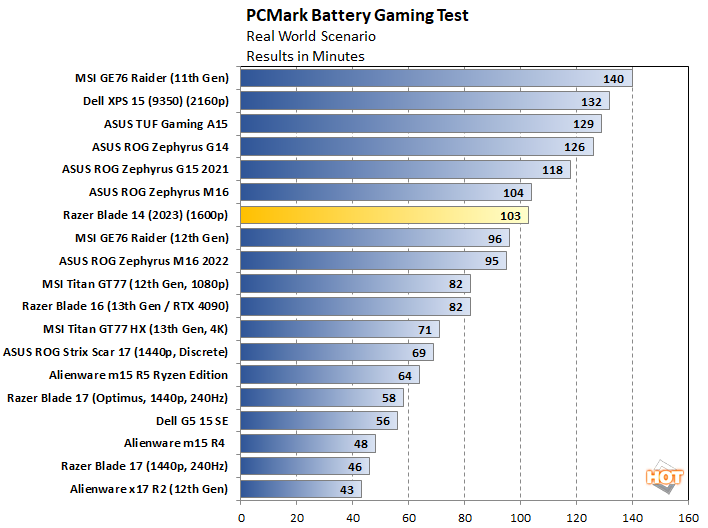
When running a simulated gaming workload where the Razer Blade 14's CPU, GPU, memory and storage are getting taxed simultaneously, battery life is obviously lower, but it still relatively strong. The Blade 14 ran for nearly 2 hours on battery which isn't bad at all, relative to other high-performance gaming laptops.






